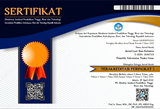The Anticancer Potency of Pandanus odoratissimus Extracts In Human Breast Cancer (MCF-7) Cell Line
Abstract
The development of novel chemical entities, novel pharmaceuticals, and novel drug leads frequently involves the use of natural sources. One of the most well-known plants, Pandanus odoratissimus (Pandanaceae), is native to Malaysia and has long been used in Ayurvedic medicine to treat a variety of illnesses. The purpose of this study is to determine P odoratissimus's antioxidant and anticancer properties against MCF-7 human breast cancer cell lines. The 2, 2-diphenyl-1-picrylhydrazyl (DPPH) free radical scavenging activity was used to assess antioxidant activity, and among the other extracts, core exhibited the highest antioxidant value. An MTT assay was used to assess the effects of plant components on MCF-7 cell lines (3-(4, 5-dimethylthiazolyl)-2, 5-diphenyl-tetrazolium bromide). The concentration of samples was shown to considerably boost the antioxidant activities in P. odoratissimus extracts. Our findings demonstrated that, after receiving treatment for 72 hours, sample treated cancer cells experienced a decline in cell viability. The IC50 value of 88.00 mg/ml indicates that the extracts have a poor cytotoxic impact and have no promise as anticancer agents against MCF-7, which is why it’s killing efficiency in cancer cells is regarded as lower.
Full Text:
PDFReferences
Abdalla, A. E., & Roozen, J. P. 1999. Effect of plant extracts on the oxidative stability of sunflower oil and emulsion. Food Chemistry, 64: 323-329.
Andriani, Y., Ramli, N.M., Syamsumir, D.F., Kassim, M.N.I., Jaafar, J., Nur Asniza Azis, Marlina, L., Musa, N.S., Mohamad, H. (2019). Phytochemical analysis, antioxidant, antibacterial and cytotoxicity Activities of keys and cores part of Pandanus tectorius fruits. Arabian journal of Chemistry, 12(8): 3555-3564.
Avila, M. A., Velasco, J. A., Cansado, J. & Notario, V. 1994. Quercetin mediates the down regulation of mutant p53 in human breast cancer line MDA-MB468. Cancer Resistance, 54: 2424-2428.
Bhanot, A., Sharma,, R., & Noolvi, M. N. 2011. Natural sources as potential anti-cancer agents : A review, 3: 9–26.
Bjeldanes, L. F., & Chang, G. W. Mutagenic activity of quercetin and related compounds. (1977). Science Journal, 197:577-578.
Cragg, G. M., & Newman, D. J. 2005. Plants as a source of anti-cancer agents. Journal of ethnopharmacology, 100(1-2), 72–9.
de Luna FCF, Ferreira WAS, Casseb SMM, de Oliveira EHC.2023. Anticancer Potential of Flavonoids: An Overview with an Emphasis on Tangeretin. Pharmaceuticals, 16(9):1229.
Du, G., Lin, H., Wang, M., Zhang, S., Wu, X., Lu, L., Ji, L., & Yu, L. 2010. Quercetin greatly improved therapeutic index of doxorubicin against 4T1 breast cancer by its opposing effects on HIF-1α in tumor and normal cells. Cancer Chemother Pharmacol, 65: 277-287.
Duthie, S. J, Johnson, W., & Dobson, V. L. 1997. The effect of dietary flavonoids on DNA damage (strand breaks and oxidised pyrimidines) and growth in human cells. Mutation Resistance, 390: 141-151.
Ghasemzadeh, A., Jaafar, H. Z. E. & Rahmat, A. 2010. Antioxidant activities, total phenolics and flavonoids content in two varieties of Malaysia young ginger (Zingiber officinale Roscoe). Molecules, 15: 4324-4333.
Ghasemzadehm, A., Jaafar, H. Z. E. & Rahmat, A. 2010. Identification of some flavonoids components in Malaysia young ginger (Zingiber officinale Roscoe) varieties by a high performance liquid chromatography method. Molecules, 15: 6231-6243.
Gogte, V. M. 2000. Ayurvedic pharmacology and therapeutic uses of medicinal plants. Mumbai: SPARC, Trans. Bharatiya Vidya Bhavan, 466-468.
Itharat, A., Houghton, P. J., Eno-Amooquaye, E., Burke, P. J., Sampson, J. H. & Raman. 2004. A: In vitro cytotoxic activity of Thai medicinal plants used traditionally to treat cancer. Journal of Ethnopharmacol, 90: 33-38.
Ito, N., Hagiwara, A., Tamano, S. 1989. Lack of carcinogenicity of quercetin in F344/DuCrj rats. Japan Journal of Cancer Resistance, 80: 317-325.
Kopustinskiene, D.M., Jakstas, V., Savickas A, Bernatoniene J. 2020. Flavonoids as Anticancer Agents. Nutrients. 12(2):457.
Miodini, P., Fioravanti, L., DiFronzo, G. & Cappelletti, V. 1999. The two phyto-oestrogens genistein and quercetin exert different effects on estrogen receptor function. British Journal of Cancer, 80(11): 1150-1155.
Molyneux, P. 2004. The use of the stable free radical diphenyl picryl hydrazyl (DPPH) for estimating antioxidant activity. Songklanakarin Journal Science Technology, 26(2): 211-219.
Nakayasu M, Sakamoto H & Terada M. 1986. Mutagenicity of quercetin in Chinese hamster lung cells in culture. Mutation Resistance, 174:79-83.
Premila, M. S. 2006. Ayurvedic herbs: A clinical guide to the healing plants of traditional Indian medicine. The Haworth Press, New York.
Sanchez-Moreno, C., Laraurri, J. & Saura-Calixto, F. 1999. Free radical scavenging capacity of selected red and white wine. Journal Science Food Agriculture, 79: 1301-1304.
Scambia, G., Ranelletti, F. O. & Panici, P. B. 1994. Quercetin potentiates the effect of andriamycin in a multidrug resistant MCF-7 human breast cancer cell line. P-glycoprotein as a possible target. Cancer Chemotherapy Pharmacol. 34: 459-464.
Yip, C. H., Aishah, N., Taib, M., & Mohamed, I. 2006. Mini-Review Epidemiology of Breast Cancer in Malaysia, 7: 369–374
Yousefzadi, M., Sharifi, M., Behmanesh, M., Moyano, E., Bontill, M., Cusido, R. M.. 2010. Podophyllotoxin: Current approaches to its biotechnological production and future challenges. England Life Science, 10: 281-292.
DOI: https://doi.org/10.35308/jlik.v6i1.9275
Refbacks
- There are currently no refbacks.
Copyright (c) 2024 Yosie Andriani
e-ISSN: 2684-7051| DOI:
10.35308
Jl. Alue Peunyareng, Ujong Tanoh Darat, Meureubo, Kabupaten Aceh Barat, Aceh 23681, Indonesia
(0655) 7110535 | +62 822-6886-3033

This work is licensed under a Creative Commons Attribution-ShareAlike 4.0 International License.













